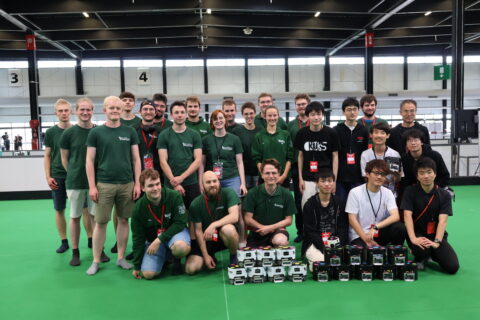Now, the second game ER-Force vs. KIKS starts.
First Half
| 05:00 | The third match of the day between ER-Force and KIKS starts with a 25-minute delay. We play as the blue team with white covers, while KIKS is the yellow team with black covers. |
| 03:29 | Surprisingly, the game is flowing relatively smoothly compared to our first match. However, our fleet is diminishing. We started with 9 robots, but now we’re down to only 4. |
| 02:52 | Many dangerous situations in our half. Overall, the game is playing out much more in our half than in the opponent’s half. |
| 02:26 | Almost a goal against us! Good pass from a KIKS robot to its teammate, who shoots towards the empty goal, but misses! |
| 02:08 | After many other dangerous situations, ER-Force calls a timeout. |
| 02:08 | KIKS follows ER-Force’s timeout with a timeout of their own, significantly delaying the game. |
| 01:49 | Almost a goal by us! Our robot kicks across the field toward the opponent’s goal, the entire defense is open, but the goalkeeper makes the save. |
| 00:31 | The game is meandering along. Not many major actions on both sides. |
| 00:24 | Almost a goal against us! But the ball was moving at 8.4 m/s, significantly faster than the allowed 6 m/s. |
| 00:15 | Another dangerous situation. Our ER-Force bots are shaking their heads in frustration. |
| 00:00 | Half-time, finally. The first half was clearly dominated by KIKS, with no signs of the performance of a vice world champion. We need to step up, or we might get eliminated in the group stage! |
Second Half
| 05:00 | The game continues. The teams have swapped jersey colors at half-time: ER-Force is now yellow, and KIKS is blue. |
| 04:09 | At least we got closer to the goal, even though we didn’t capitalize on it: The pass into the opponent’s half sails past our robot, and it shows no inclination to change that. |
| 02:22 | Another shot on goal by KIKS, but our keeper makes the save. |
| 01:50 | Another shot on our goal, but again, no goal this time. |
| 00:36 | And yet another unsuccessful shot on our goal. |
| 00:00 | Objectively, the game ends in an undeserved 0-0 draw. In summary, we were very lucky. While we could defend the last match against Immortals with our current poor performance, we would have systematically lost this game if it had gone into overtime. |
It appears that the issues with our robots are currently quite diverse:
- The HBC radio communication doesn’t seem to be working properly. Everything seems fine during the practice slots when we have the field to ourselves, but as soon as a real game is played, the radio signal deteriorates significantly. It’s actually the radio communication, not the control system as previously thought, responsible for the overshooting of the robots and the breakdown of the lanes. Our suspicion is that we’re doing something wrong in the firmware and/or software since the HBC radio has proven to be extremely robust and practically indestructible in our experience.
- The “battery cages,” which are the mechanical components that stabilize the battery in the robot, regularly break completely. These were designed for much lower forces, but the batteries are causing significantly higher forces during braking and crashes.
- The motor boards, which are the boards responsible for controlling each motor, frequently fail when powered on. This issue has been known for a while, but the boards are remnants from the semiconductor crisis, meaning they are a patchwork of components that were available back then and are so expensive that we can’t afford to make new ones.
- The tachometers often give nonsensical readings. This is likely because they are only supported on one side, causing them to vibrate during driving.
- The current measurements sometimes return nonsensical values, causing the motor control based on them to only partially regulate the motor.
All in all, there are quite a few challenges that we need to address.


